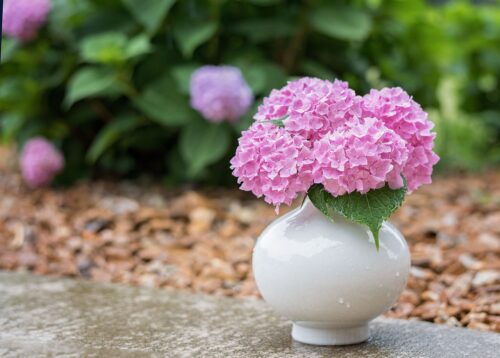Find the best tips on How to Revive Hydrangeas with the help of this guide below, which includes expert suggestions.
If you’ve experienced the disappointment of hydrangeas wilting prematurely in a bouquet, you’re not alone. But instead of discarding them, discover how to revive hydrangeas with these simple techniques to prolong their beauty. With this method, you can often revive most of the blooms, allowing you to enjoy them for several more days.
Read: How to Grow Hydrangeas
Reason Behind Wilting of Cut Hydrangea Blooms Fast

Hydrangeas are usually the first flowers to droop in a bouquet because their thick stems ooze sticky sap. This makes it hard for them to soak up enough water in a vase to reach the blossoms. Luckily, hydrangeas can absorb water through their flowers. So, if they wilt, you can revive them by entirely putting blooms in water for a few hours.
This method might not always work for hydrangeas, but it’s worth a try if you have a few stems you’re not ready to throw away. The success of this technique depends on factors like when the flowers were cut and how long they’ve been stored in cold storage after harvesting. You’ll have better luck reviving slightly wilted fresh-cut hydrangeas compared to those that have been stored longer. Although it’s not guaranteed to work perfectly, it’s still worth a shot.
Note: This method to revive hydrangeas won’t work for other cut flowers such as roses, peonies, or tulips. Unlike hydrangeas, only a few flowers can absorb water through their petals. Soaking those flowers will actually cause them to rot and wilt faster.
How to Revive Hydrangeas

Here are some techniques to encourage your hydrangeas to last three to five additional days.
Offer Them a Soak
Soak the wilting hydrangea blooms in warm water for 30-40 minutes. This suggestion is provided by experienced gardeners and florists.
This trick works as hydrangeas absorb water not only through their stems but also through their flower petals. Submerging your cut hydrangeas allows the flowers ample opportunity to absorb plenty of water, reviving them.
Cut the Stems
One more tip is trimming the stems. While many know that fresh-cut bloom stems can prolong the life of bouquets, famous florists emphasize a crucial aspect: “Longer stems make it more difficult for water to reach the flowers.”
Trimming the stems to a shorter length and making a crisscross slice up into them is another method to facilitate water uptake. Some florists advise against crushing the stems, a practice sometimes suggested for flowers with woodier stems, such as lilacs. “Crushing the stems can damage the vascular tissues responsible for water absorption,” they explain.
Use Boiling Water
Hydrangeas often develop a sap-like substance on the cut stems, restricting the continuous flow of water to the flowers and resulting in drooping. To address this, boil water in a kettle and pour it into a container. Remove the wilted hydrangeas from your arrangement and trim the stems at a 45-degree angle. Create a vertical slit in the incision and briefly immerse the stem upright in the boiling water for approximately 60 seconds. Reintegrate the hydrangeas into your floral arrangement, and they should rejuvenate within about an hour.
Tips to Save Your Next Hydrangea Bouquet
Many experienced florists advise avoiding cutting hydrangea blooms when they’re too young, as they retain a lot of moisture in their petals. It will be best to wait until the flowers develop a papery or even “leathery” texture. By doing so, your hydrangea blooms will have a longer lifespan in your bouquet.



